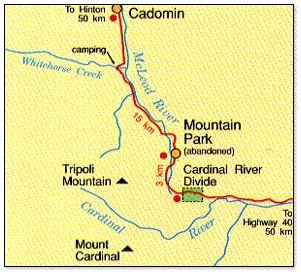The
proposed development of Cheviot Mine, British Columbia

The
proposed development of Cheviot Mine, British Columbia

The Cardinal Divide region of Alberta is located on the eastern boundary of Jasper National Park, the largest National Park in the Canadian Rockies, which has been promoted as

The Cardinal Divide region is home to many rare and endangered species and has been designated a Critical Wildlife Area

Conflict Timeline
1996: Cardinal River Coals Limited announces plans to develop an open-pit coalmine, the Cheviot Mine, in the Cardinal Divide Region. The proposed mine is 23 km by 3.5 km and is located 1.8km from the Jasper National Park boundary

Employees of another mine in the area, residents of the nearby town of Hinton, and the Alexis First Nation support
the Cheviot Mine project, as it is predicted to create over 900 jobs and inject Canadian $400 million into
the provincial economy over 20 yearsA joint Federal and Provincial environmental assessment panel approve the project
1997: A legal challenge to the approval is launched by a coalition of five environmental groups, supported by Parks Canada and Smallboy Camp First Nation, who claim the review was incomplete because the panel was not provided with comprehensive information on the environmental impacts of the development
Issues of concern included possible damage to important Grizzly bear habitat, destruction of the nesting and brooding habitat of the endangered Harlequin duck species, and obliteration of Red Cap Creek, which is used as a medicinal plant gathering area and coming-of-age area by the Small Camp community
1999: The Federal Court of Canada reverses approval for the project, concluding that the original assessment procedure did not take into account possible alternatives to the mine or consider the cumulative environmental impacts
Cardinal River Coals Limited instigates a new environmental assessment application
2000: Cardinal River Coals Limited announces an indefinite postponement to the mine, development caused
by the withdrawal of the company’s main coal-buying client. The “prolonged environmental approval process”
was blamed for the loss